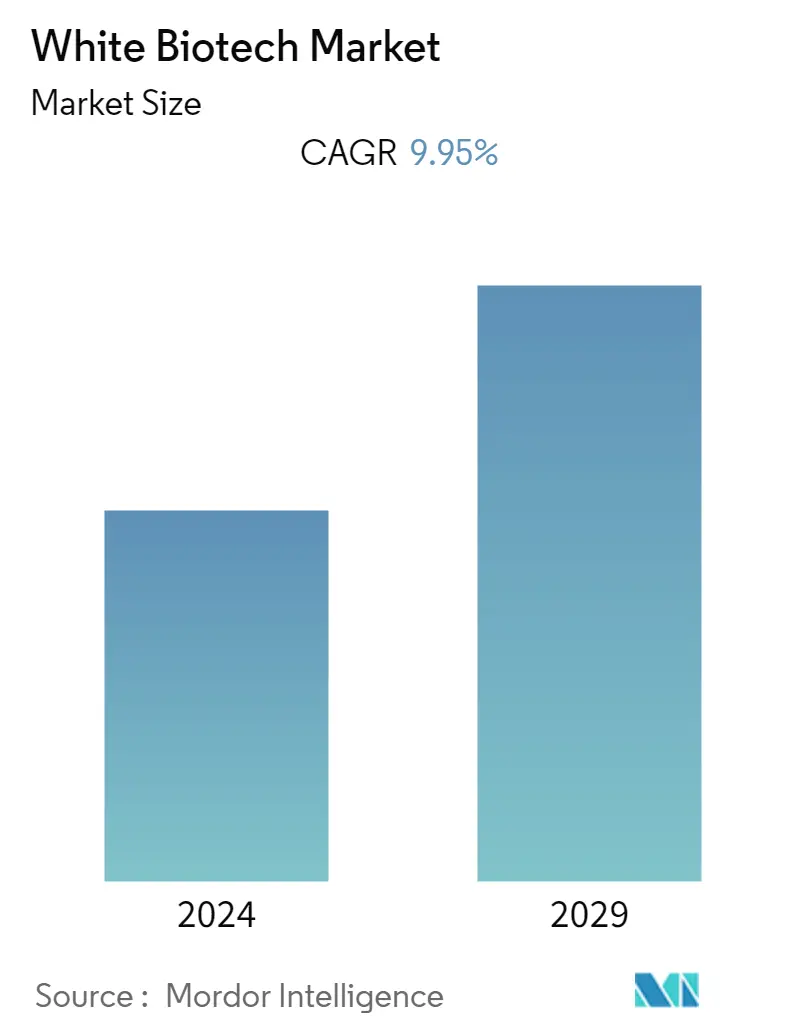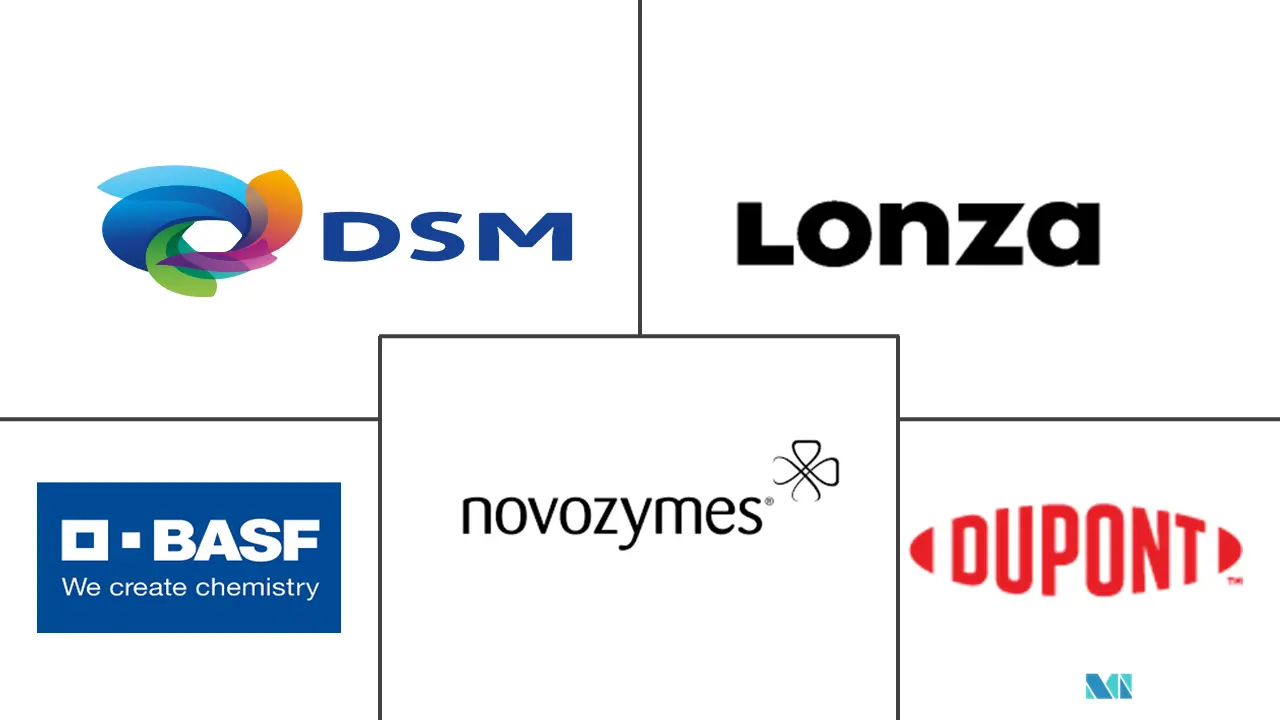Market Size of White Biotech Industry

| Study Period | 2019 - 2029 |
| Base Year For Estimation | 2023 |
| CAGR | 9.95 % |
| Fastest Growing Market | Asia-Pacific |
| Largest Market | North America |
| Market Concentration | Low |
Major Players
*Disclaimer: Major Players sorted in no particular order |
White Biotech Market Analysis
The white biotech market is currently valued at USD 315 billion and is projected to register a CAGR of 9.95% during the forecast period.
- White or industrial biotechnology is one of the most promising approaches to pollution prevention, resource conservation, and cost reduction, as it can reduce carbon dioxide emissions, energy consumption, and water consumption by 50%, 20%, and 75%, respectively. Moreover, as the fight against climate change becomes increasingly important, people worldwide are willing to pay more for sustainability.
- Consumers are increasingly making purchasing decisions based on environmental considerations and seeking products that use sustainable materials or processes with minimal adverse environmental effects. Such changes in purchase patterns encourage retailers and manufacturers to adopt white biotechnology to produce value-added chemicals from renewable sources.
- White biotechnology provides valuable components for the food, pharmaceutical, and agricultural sectors, as well as other industries. Many companies and brands are aware of the ongoing trend toward protecting the environment and are taking steps to promote sustainability. One such effort is that various consumers from industries, including automotive and consumer goods, focus on white biotechnology to meet sustainability targets and boost sales.
- Government bodies of several countries support emerging biofuel industries via subsidies, mandates, fuel tax adjustments, and incentives for using flex-fuel vehicles. For example, the United States, the European Union, Brazil, China, and others have started developing extra incentives for second-generation biofuels.
- Furthermore, in countries like India, the ban on single-use plastics and emphasis on utilizing recycled and reused materials to reduce dependency on fossil fuel sources, such as crude oil import, encourages companies to develop innovative eco-friendly packaging materials. Thus, such initiatives are accelerating the global white biotechnology market growth.
White Biotech Industry Segmentation
White biotechnology, also known as industrial biotechnology, refers to the use of enzymes and microorganisms to produce bio-based products for use in sectors, such as chemicals, food and feed, healthcare, consumer goods, and automotive.
The white biotech market is segmented on the basis of type, application, and geography. Based on type, the white biotech market report is segmented into biofuels, biomaterials, biochemicals, and industrial enzymes. Based on application, the market report is segmented into bioenergy, pharmaceuticals, food and beverage, feed, and other applications. By geography, the market is segmented into North America, Europe, Asia-Pacific, South America, Middle East, and Africa.
The market sizing has been done in value terms in USD for all the above-mentioned segments.
| By Type | |
| Biofuels | |
| Biomaterials | |
| Biochemicals | |
| Industrial Enzymes |
| By Application | |
| Bioenergy | |
| Pharmaceuticals | |
| Food and Beverages | |
| Feed | |
| Other Applications |
| Geography | ||||||||
| ||||||||
| ||||||||
| ||||||||
| ||||||||
|
White Biotech Market Size Summary
The white biotechnology market is experiencing significant growth, driven by increasing consumer demand for sustainable and eco-friendly products. This sector, which focuses on using biological processes and organisms to create industrial products, is gaining traction as businesses and consumers alike prioritize environmental sustainability. The shift in consumer purchasing behavior towards products with minimal environmental impact is encouraging manufacturers and retailers to adopt white biotechnology processes. This trend is further supported by government initiatives worldwide, promoting the use of biofuels and sustainable materials, which are crucial in reducing dependency on fossil fuels and minimizing environmental footprints. The market's expansion is also fueled by its applications across various industries, including food, pharmaceuticals, and agriculture, where it provides valuable components and solutions for sustainability.
In the Asia-Pacific region, the white biotechnology market is witnessing robust growth due to the increasing demand for sustainable solutions and biotechnologically altered products. Countries like China and India are leading this growth by emphasizing sustainability and environmental protection, which drives the adoption of white biotechnology across sectors such as healthcare, agriculture, and waste management. The region's strong research capabilities and innovative ecosystem attract significant investments from both local and foreign companies, further propelling market expansion. The competitive landscape of the white biotechnology market is characterized by the presence of major global players who are focusing on innovation and the development of new products to meet the growing demand for sustainable industrial solutions.
White Biotech Market Size - Table of Contents
-
1. MARKET DYNAMICS
-
1.1 Market Drivers
-
1.1.1 Increasing Consumer Demand for Products with Low Environmental Impacts
-
1.1.2 Dedicated Policies and Government Efforts to Promote the use of Biotechnology
-
-
1.2 Market Restraints
-
1.2.1 Deteriorating Fertility of Agricultural Lands
-
-
1.3 Porter's Five Forces Analysis
-
1.3.1 Threat of New Entrants
-
1.3.2 Bargaining Power of Buyers/Consumers
-
1.3.3 Bargaining Power of Suppliers
-
1.3.4 Threat of Substitute Products
-
1.3.5 Intensity of Competitive Rivalry
-
-
-
2. MARKET SEGMENTATION
-
2.1 By Type
-
2.1.1 Biofuels
-
2.1.2 Biomaterials
-
2.1.3 Biochemicals
-
2.1.4 Industrial Enzymes
-
-
2.2 By Application
-
2.2.1 Bioenergy
-
2.2.2 Pharmaceuticals
-
2.2.3 Food and Beverages
-
2.2.4 Feed
-
2.2.5 Other Applications
-
-
2.3 Geography
-
2.3.1 North America
-
2.3.1.1 United States
-
2.3.1.2 Canada
-
2.3.1.3 Mexico
-
2.3.1.4 Rest of North America
-
-
2.3.2 Europe
-
2.3.2.1 Germany
-
2.3.2.2 United Kingdom
-
2.3.2.3 France
-
2.3.2.4 Spain
-
2.3.2.5 Italy
-
2.3.2.6 Rest of Europe
-
-
2.3.3 Asia-Pacific
-
2.3.3.1 China
-
2.3.3.2 Japan
-
2.3.3.3 India
-
2.3.3.4 Australia
-
2.3.3.5 Rest of Asia-Pacific
-
-
2.3.4 South America
-
2.3.4.1 Brazil
-
2.3.4.2 Argentina
-
2.3.4.3 Rest of South America
-
-
2.3.5 Middle-East and Africa
-
2.3.5.1 South Africa
-
2.3.5.2 Saudi Arabia
-
2.3.5.3 Rest of Middle-East and Africa
-
-
-
White Biotech Market Size FAQs
What is the current White Biotech Market size?
The White Biotech Market is projected to register a CAGR of 9.95% during the forecast period (2024-2029)
Who are the key players in White Biotech Market?
Dupont De Nemours, Inc., Novozymes A/S, Lonza Group Ltd, Koninklijke DSM NV and BASF SE are the major companies operating in the White Biotech Market.

